Stealth aircraft, which could change the outcome of the war (9 photos)
 Bashny.Net
Bashny.Net
High speed stealth bomber, but 229 could well change the course of World War II.
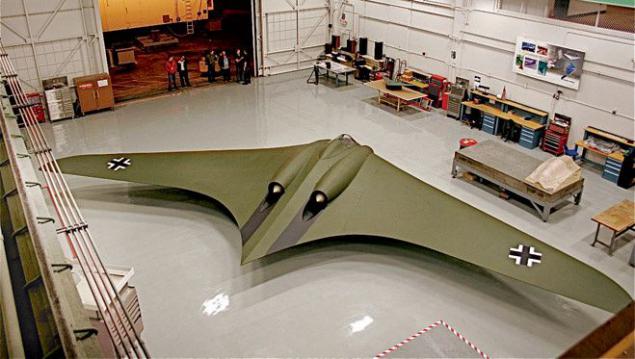
Upcoming part of the 7th Corps of the 3rd Army USA 14 April 1945 entered the German city Fridrihsrode and seized the plant located there Aircraft company "Gotha". Also standing in abandoned shops operating twin-engined fighter "Messerschmitt", which is built under license, before the eyes of the Americans brought a strange-looking device. If the soldiers then found even one visitor from the not too distant future, he would exclaim in amazement: "Where here in the past, took our ultra-modern" stealth "- B-2 bomber?" But the newcomers among the rangers did not have, and therefore incomprehensible the plane was soon drafted without any hesitation to send to America. Man, who performed the operation "Sea Horse", there was no time to think. They darted across the defeated Reich, collecting promising developments of German engineers and saving them from the Soviet occupation zone. Scouts good idea what they are looking for and what can be found. For them, the third prototype developed by the Horten brothers and build on the "Gotha" jet bomber "flying wing" Ho-229 V3 was a welcome find.
To fly with one wing
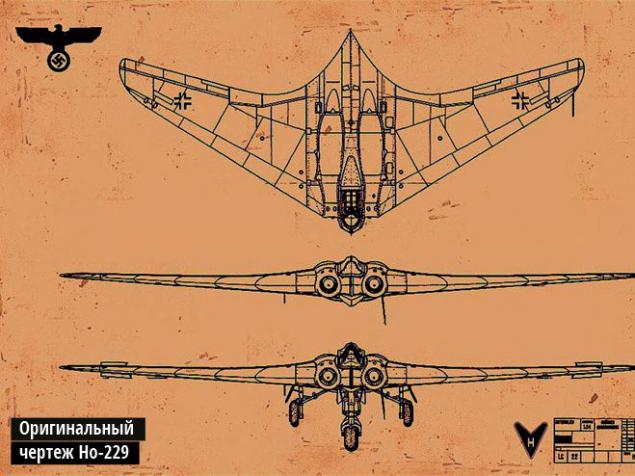
The fact is that at this time in the United States worked outstanding aviation engineer John Knudsen "Jack" Northrop. During the war, just like the engineers do not usually work, and perform military program, so that John Northrop also not amused, and was trying to bring in the metal unusual demands of the American Air Corps - the so-called "condition of 10,000 to 10,000." It was necessary to create a bomber capable of carrying combat load of 10 000 pounds (4500 kg) 10 000 miles (16 000 km). Northrop got into a lost cause because, like his German colleagues - brothers Walter and Reimar Horten, believed in the benefits of unusual aerodynamic scheme. Interestingly, Horten also participated in the program with a very similar name - "1000 x 1000 x 1000" just announced its Luftwaffe chief Hermann Goering. In the German version of the task was to create a bomber capable of carrying 1,000 kg of bombs over a distance of 1000 km at a speed of 1000 km / h.

John Northrop long been engaged in the development of "flying wing" - planes without fuselage and tail, in fact only one wing and composed. The "flying wing" does not stray from the point of view of aerodynamics parts not create lift, but increases the weight of the aircraft and the resistance of air flow. The entire payload can be uniformly distributed directly inside the wing, which gives tremendous benefits in terms of strength, and hence mass structure.
More December 17, 1942 the US Air Force ordered the firm Northrop several pre-production samples of its YB-35 bomber for testing, but the problems with the handling of the new car and the difficulty of its construction is not allowed to rely on the execution of the order in time. In this connection, made in the same aerodynamic configuration captured German No-229, a prototype of which has already made several flights since March 1, 1944, came in handy.
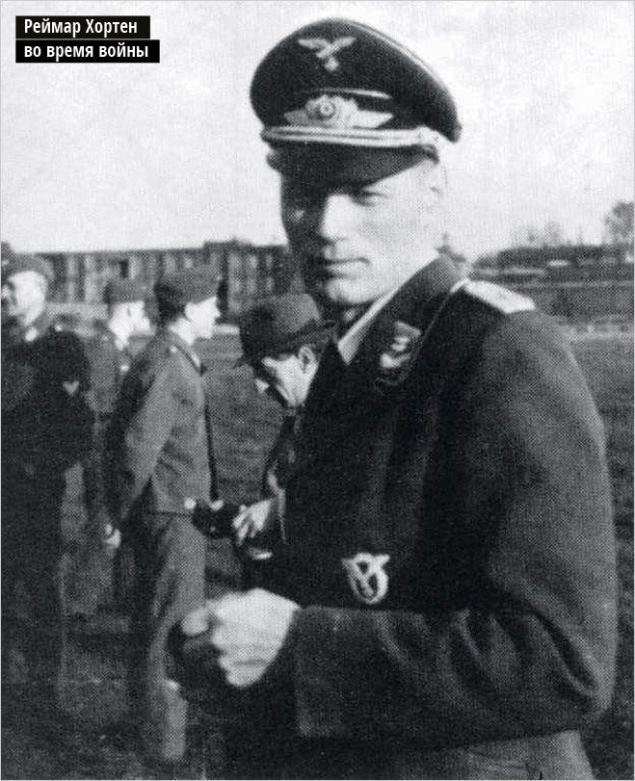
However, despite the study of the German answer to the eternal question of perspective layout of the aircraft, the program "flying wing" Northrop still has not brought the US military would satisfy the results and was closed in the late 40s. Well-studied along and across No-229 took its place at the Washington National Aerospace Museum of the United States only as an example of the notorious German "wonder weapons".
The eyes of the Americans brought a strange-looking device
Again, we recall the "Horten" in the 70s. Then a close acquaintance with the results of the first Soviet air defense missile systems and radars management over the jungles of North Vietnam plunged the American command of the aircraft in a real shock. Urgent work was begun to reduce the effective surface scattering radio aerial vehicles, leading to the appearance in the final group technology "stealth" (from the English stealth - deceiving, misleading). It turned out that among other benefits "flying wing", which has no protrusions and mating flat surfaces easily optimized to reduce radar visibility of the aircraft. In addition, there is automatically maintained straight flight by-wire control system, will help to overcome the main disadvantage of this scheme aircraft - instability in flight and irrepressible tendency to lift the nose.
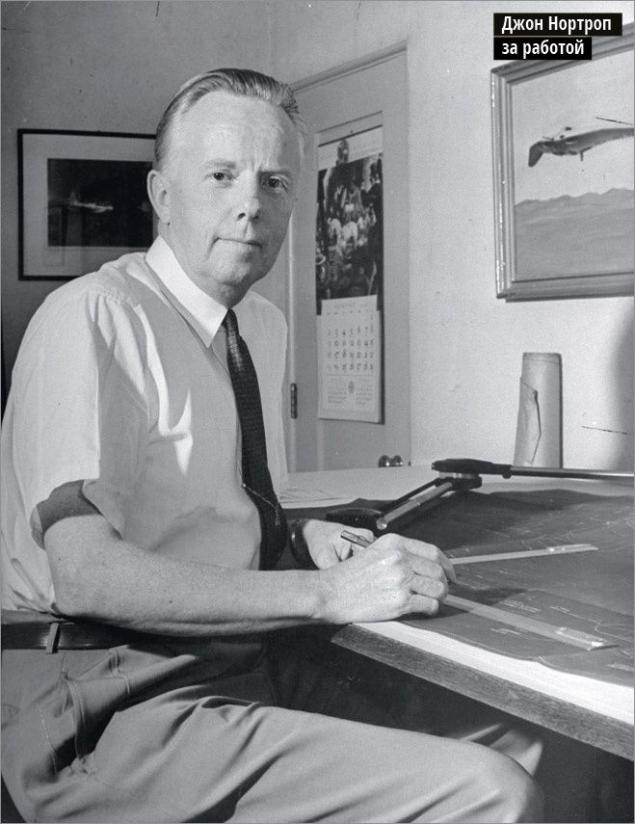
Experiments Horten brothers John Northrop and thus paved the way for the creation of ultra-modern stealth bomber B-2 Spirit of Northrop-Grumman. However, the "invisibility" B-2 not only contributes its aerodynamic design, but widespread use of carbon materials and coat airplane special absorbing materials and paints.
Jack Northrop died Feb. 18, 1981, eight years before they start to "Spirit's" production. But the youngest of Horten, Reimar, who was the main ideologist and the driving force behind the development of the military "flying wing" in the Third Reich, happily lived in Argentina until 14 March 1994. During the general madness that has engulfed the media with the message of the American "stealth aircraft", he managed to write many articles and give a lot of interviews, which showed that the world's first "stealth" invented and built it in Germany and that they are brothers Horten. In particular, in 1982 he published the book came out, "Flying Wings: History aircraft Horten. 1933-1960 ", where Reimar Horten says, among other things, that the information contained in the three-layer plating charcoal" have dissipated rays radar and would make the plane invisible to them. "
Well, stealth?
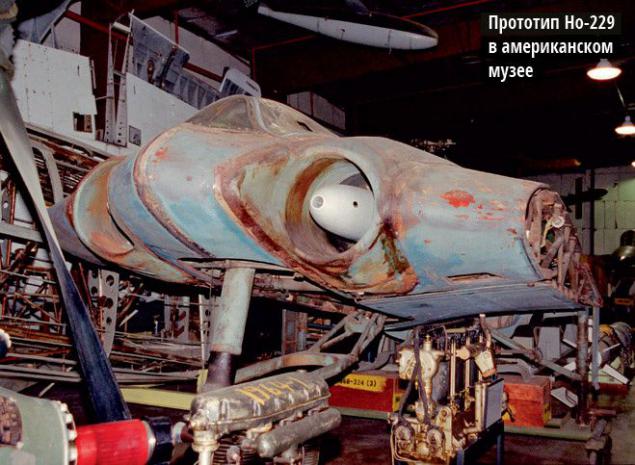
Since then, fans of military history and art is haunted by the question: we can assume that the engineers of the Third Reich invented the technology "stealth" or not? Several conversations with Walter (he lived longer than his brother and died on 9 December 1998) and Reimar American historian David Mihr in his book "The Brothers Horten and flying wings," wrote of who served in the Luftwaffe Major Walter Horten the following: "He was executed revenge (for the loss of the Germans in the Battle of Britain "in 1940) and felt the need to create a glider that would be invisible to the British anti-system".
However, a thirst which actually was "executed" by Walter - an ambiguous question. Rather, it's still not revenge, but money and fame. In any case, the allocated Reichsmark Luftwaffe bomber instead ordered the brothers in 1945 were engaged in full swing construction of sports glider H XIV, assuming it profitable to sell after the war.
In terms of sensationalism version of the invention, an aircraft invisible in 1943 it looks much more attractive, so the American television channel National Geographic this year decided to put the experiment. He commissioned experts of the corporation Northrop-Grumman (the same one that created-and B-2), using the German trophy documents and measurements preserved in the museum of the original sample, built under the supervision of an expert on technology "stealth" Tom Dobrentsa layout No-229 full size and "because of the materials' that were used once in Germany. Fly it, however, can not, but this is not required. The whole idea worth 250 thousand dollars and 2,500 man-hours of work was arranged to test for "stelsovost."
National Geographic wanted to check whether the No-229 was the world's first aircraft with low radar signature. Well, this is a film about the lift, of course.
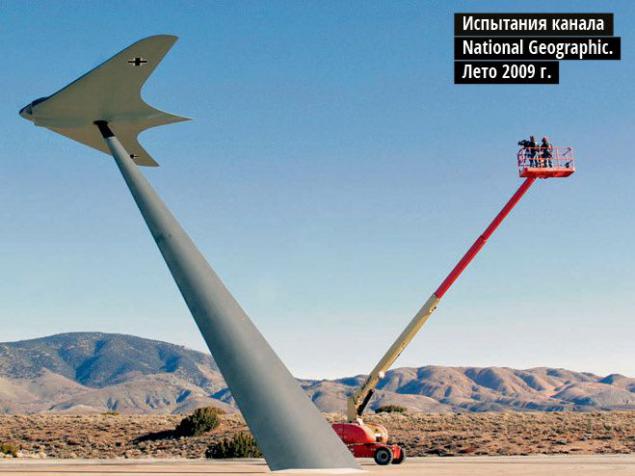
In January 2009, in the California Mojave desert layout of the aircraft has been installed on the pylon and radar irradiated with the same frequency signal with approximately the same characteristics as that of the early warning systems of air defense of Great Britain during the Second World War. It turned out that the radar signature layout No-229 "flying" at an altitude of 15-30 meters (at a height during the war, these German planes sneaked to the chalk cliffs of Dover across the English Channel), about 20% lower than that of airplanes the usual scheme. In other words, if the Messerschmitt Bf.109 or Focke-Wulf Fw 190 radar spotted the British would range of 160 km, the Ho-229 - only when it approaches the target at 129 km. The difference is small, but the speed of 840 km / h (namely, a result shown in tests in 1944, the prototype "Horten") bomber would cover the distance in 9 minutes to 19 minutes, which would require an ordinary plane to overcome its 160 km. Accordingly, the British pilots of these 9 minutes and would have stayed out to get a warning about the attack, fly, climb, and to find in the sky attacking enemy. Even for the best of English at the time (too reactive) fighter Gloster Meteor Mk 1 with its maximum speed of 676 km / h an impossible task, not to mention the much more massive at the time of screw "Spitfire"!
Moreover, the study authentic Ho-229 showed that between layers of plywood which was encased toe wing is a carbonaceous material type. "Personally I can not understand why others do it, other than to deal with radars," - says Dobrents. But even if this is so, he adds, can not be a hundred percent sure that the German engineers intentionally walked to it or understand that their technology works.
Debriefing
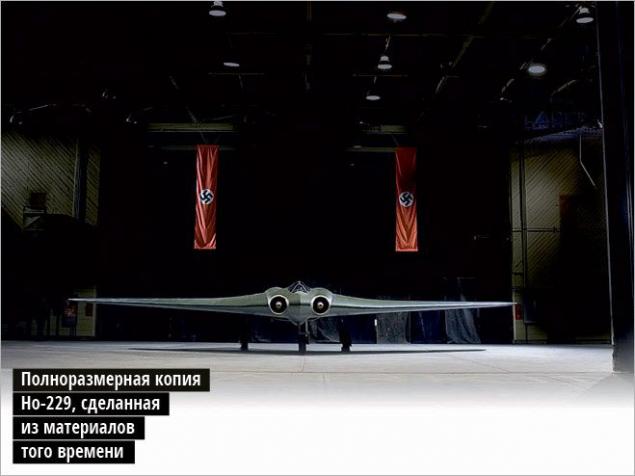
Doubts Tom Dobrentsa the more clear that the layout - it's still not a real plane. The skeleton of the Ho-229 was a skeleton of steel pipes and profiles, somewhere interconnected at a right angle, that is the perfect corner reflector of radio waves. A layout for ease of construction was collected on a plywood frame. And the layout and the plane sheathed with plywood, relatively well-transmitting radio waves. Accordingly, a significant role in the visibility of the device on the radar screen would play signal reflection not only on the skin, but on the internal steel frame. It may well be that the notorious 20% of "invisibility" in the real world would lose half, if not more. Even more interesting is the situation with the "carbonaceous material such as" in the skin. One of the advantages of the aircraft Horten was able to produce its units in the most simple terms, it was very important for Germany at the end of the war. Therefore plating of metal was not considered in principle - just plywood. But at the stated high speed flight trim the leading edge of the wing had to have high strength. The situation could have saved a composite material such as that used in the casing of the high-speed bomber British De Havilland 98 Mosquito, also built of wood and familiar to the Germans. There between the layers of plywood was made of light balsa filler - about the same principle arranged in honeycomb structures of modern aircraft. But balsa tree grows in South America - 1944 Germany is like on Mars. Then to replace this natural foam German engineers have come up with a composite of ersatz abundant materials called "formholts." It interval between the layers 1 and 5 mm plywood was filled with a mixture of resin-impregnated porous sawdust and charcoal. Because of formholtsa it was made lining the front of the "flying wing" Horten.
To carry 1,000 kg of bombs over a distance of 1000 km at a speed of 1000 km / h
Horten selected aerodynamic configuration of the aircraft, too, was hardly the result of a conscious desire to achieve a low radar visibility - rather, the result of a decade of practical use "flying wing". But the need to eliminate the possibility of the line of sight of the compressor blades of jet engines Jumo-004V via the air intake (they make a significant contribution to chart visibility jet), the brothers did not know, and therefore nothing in this direction are not taken.
External similarity of B-2 Spirit and Ho-229 often pushes supporters of the idea "German stealth" to carry out even more interesting parallels. Sometimes they write that Horta allegedly covered surface radar absorbing paint their vehicles from a mixture of coal dust and polish. Mental analogy with modern coatings B-2 is obvious, but only in a belligerent Germany this material was not. We developed just before the end of the "Thousand-Year Reich" radar absorbing material "sumpf" to cover the protruding above the water surface logging submarines: radar-equipped planes British coastguard very much annoyed. But it was a thick layer of rubber particles with inclusions of iron. Cover sheets of such heavy aircraft was, in principle, only he probably would not have taken off ...
The last argument
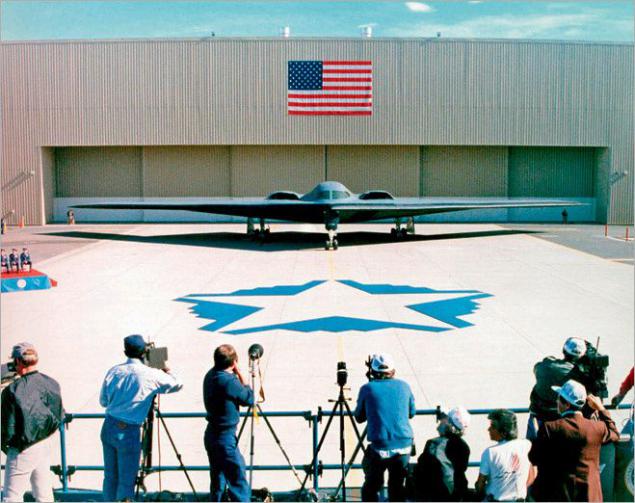
However, the simplest explanation of what Horta did not design "Stealth" is that no one of them is never required. This simply was not necessary. If even a plane at a rate of 800-1000 km / h, armed with four 30 mm cannons MK-108 and carrying a ton of bombs, flies to Britain, you can not stop it. Just nothing, even if the radar operator clearly sees it on the screen. Even the brothers about the "invisibility" of their offspring have reflected much later, when their merit to have forgotten, but still wanted to glory. Anyway, during the war in the report on the "flying wing" April 14, 1943 they lead all conceivable advantages of "flying wings", even "the best protection from the barrage balloons due to lack of protruding parts," but no mention of reducing the radar signature. Although without a bomber wing, whether it is adopted by could make some rustling. But then we arrived ...

Upcoming part of the 7th Corps of the 3rd Army USA 14 April 1945 entered the German city Fridrihsrode and seized the plant located there Aircraft company "Gotha". Also standing in abandoned shops operating twin-engined fighter "Messerschmitt", which is built under license, before the eyes of the Americans brought a strange-looking device. If the soldiers then found even one visitor from the not too distant future, he would exclaim in amazement: "Where here in the past, took our ultra-modern" stealth "- B-2 bomber?" But the newcomers among the rangers did not have, and therefore incomprehensible the plane was soon drafted without any hesitation to send to America. Man, who performed the operation "Sea Horse", there was no time to think. They darted across the defeated Reich, collecting promising developments of German engineers and saving them from the Soviet occupation zone. Scouts good idea what they are looking for and what can be found. For them, the third prototype developed by the Horten brothers and build on the "Gotha" jet bomber "flying wing" Ho-229 V3 was a welcome find.
To fly with one wing

The fact is that at this time in the United States worked outstanding aviation engineer John Knudsen "Jack" Northrop. During the war, just like the engineers do not usually work, and perform military program, so that John Northrop also not amused, and was trying to bring in the metal unusual demands of the American Air Corps - the so-called "condition of 10,000 to 10,000." It was necessary to create a bomber capable of carrying combat load of 10 000 pounds (4500 kg) 10 000 miles (16 000 km). Northrop got into a lost cause because, like his German colleagues - brothers Walter and Reimar Horten, believed in the benefits of unusual aerodynamic scheme. Interestingly, Horten also participated in the program with a very similar name - "1000 x 1000 x 1000" just announced its Luftwaffe chief Hermann Goering. In the German version of the task was to create a bomber capable of carrying 1,000 kg of bombs over a distance of 1000 km at a speed of 1000 km / h.

John Northrop long been engaged in the development of "flying wing" - planes without fuselage and tail, in fact only one wing and composed. The "flying wing" does not stray from the point of view of aerodynamics parts not create lift, but increases the weight of the aircraft and the resistance of air flow. The entire payload can be uniformly distributed directly inside the wing, which gives tremendous benefits in terms of strength, and hence mass structure.
More December 17, 1942 the US Air Force ordered the firm Northrop several pre-production samples of its YB-35 bomber for testing, but the problems with the handling of the new car and the difficulty of its construction is not allowed to rely on the execution of the order in time. In this connection, made in the same aerodynamic configuration captured German No-229, a prototype of which has already made several flights since March 1, 1944, came in handy.

However, despite the study of the German answer to the eternal question of perspective layout of the aircraft, the program "flying wing" Northrop still has not brought the US military would satisfy the results and was closed in the late 40s. Well-studied along and across No-229 took its place at the Washington National Aerospace Museum of the United States only as an example of the notorious German "wonder weapons".
The eyes of the Americans brought a strange-looking device
Again, we recall the "Horten" in the 70s. Then a close acquaintance with the results of the first Soviet air defense missile systems and radars management over the jungles of North Vietnam plunged the American command of the aircraft in a real shock. Urgent work was begun to reduce the effective surface scattering radio aerial vehicles, leading to the appearance in the final group technology "stealth" (from the English stealth - deceiving, misleading). It turned out that among other benefits "flying wing", which has no protrusions and mating flat surfaces easily optimized to reduce radar visibility of the aircraft. In addition, there is automatically maintained straight flight by-wire control system, will help to overcome the main disadvantage of this scheme aircraft - instability in flight and irrepressible tendency to lift the nose.

Experiments Horten brothers John Northrop and thus paved the way for the creation of ultra-modern stealth bomber B-2 Spirit of Northrop-Grumman. However, the "invisibility" B-2 not only contributes its aerodynamic design, but widespread use of carbon materials and coat airplane special absorbing materials and paints.
Jack Northrop died Feb. 18, 1981, eight years before they start to "Spirit's" production. But the youngest of Horten, Reimar, who was the main ideologist and the driving force behind the development of the military "flying wing" in the Third Reich, happily lived in Argentina until 14 March 1994. During the general madness that has engulfed the media with the message of the American "stealth aircraft", he managed to write many articles and give a lot of interviews, which showed that the world's first "stealth" invented and built it in Germany and that they are brothers Horten. In particular, in 1982 he published the book came out, "Flying Wings: History aircraft Horten. 1933-1960 ", where Reimar Horten says, among other things, that the information contained in the three-layer plating charcoal" have dissipated rays radar and would make the plane invisible to them. "
Well, stealth?

Since then, fans of military history and art is haunted by the question: we can assume that the engineers of the Third Reich invented the technology "stealth" or not? Several conversations with Walter (he lived longer than his brother and died on 9 December 1998) and Reimar American historian David Mihr in his book "The Brothers Horten and flying wings," wrote of who served in the Luftwaffe Major Walter Horten the following: "He was executed revenge (for the loss of the Germans in the Battle of Britain "in 1940) and felt the need to create a glider that would be invisible to the British anti-system".
However, a thirst which actually was "executed" by Walter - an ambiguous question. Rather, it's still not revenge, but money and fame. In any case, the allocated Reichsmark Luftwaffe bomber instead ordered the brothers in 1945 were engaged in full swing construction of sports glider H XIV, assuming it profitable to sell after the war.
In terms of sensationalism version of the invention, an aircraft invisible in 1943 it looks much more attractive, so the American television channel National Geographic this year decided to put the experiment. He commissioned experts of the corporation Northrop-Grumman (the same one that created-and B-2), using the German trophy documents and measurements preserved in the museum of the original sample, built under the supervision of an expert on technology "stealth" Tom Dobrentsa layout No-229 full size and "because of the materials' that were used once in Germany. Fly it, however, can not, but this is not required. The whole idea worth 250 thousand dollars and 2,500 man-hours of work was arranged to test for "stelsovost."
National Geographic wanted to check whether the No-229 was the world's first aircraft with low radar signature. Well, this is a film about the lift, of course.

In January 2009, in the California Mojave desert layout of the aircraft has been installed on the pylon and radar irradiated with the same frequency signal with approximately the same characteristics as that of the early warning systems of air defense of Great Britain during the Second World War. It turned out that the radar signature layout No-229 "flying" at an altitude of 15-30 meters (at a height during the war, these German planes sneaked to the chalk cliffs of Dover across the English Channel), about 20% lower than that of airplanes the usual scheme. In other words, if the Messerschmitt Bf.109 or Focke-Wulf Fw 190 radar spotted the British would range of 160 km, the Ho-229 - only when it approaches the target at 129 km. The difference is small, but the speed of 840 km / h (namely, a result shown in tests in 1944, the prototype "Horten") bomber would cover the distance in 9 minutes to 19 minutes, which would require an ordinary plane to overcome its 160 km. Accordingly, the British pilots of these 9 minutes and would have stayed out to get a warning about the attack, fly, climb, and to find in the sky attacking enemy. Even for the best of English at the time (too reactive) fighter Gloster Meteor Mk 1 with its maximum speed of 676 km / h an impossible task, not to mention the much more massive at the time of screw "Spitfire"!
Moreover, the study authentic Ho-229 showed that between layers of plywood which was encased toe wing is a carbonaceous material type. "Personally I can not understand why others do it, other than to deal with radars," - says Dobrents. But even if this is so, he adds, can not be a hundred percent sure that the German engineers intentionally walked to it or understand that their technology works.
Debriefing

Doubts Tom Dobrentsa the more clear that the layout - it's still not a real plane. The skeleton of the Ho-229 was a skeleton of steel pipes and profiles, somewhere interconnected at a right angle, that is the perfect corner reflector of radio waves. A layout for ease of construction was collected on a plywood frame. And the layout and the plane sheathed with plywood, relatively well-transmitting radio waves. Accordingly, a significant role in the visibility of the device on the radar screen would play signal reflection not only on the skin, but on the internal steel frame. It may well be that the notorious 20% of "invisibility" in the real world would lose half, if not more. Even more interesting is the situation with the "carbonaceous material such as" in the skin. One of the advantages of the aircraft Horten was able to produce its units in the most simple terms, it was very important for Germany at the end of the war. Therefore plating of metal was not considered in principle - just plywood. But at the stated high speed flight trim the leading edge of the wing had to have high strength. The situation could have saved a composite material such as that used in the casing of the high-speed bomber British De Havilland 98 Mosquito, also built of wood and familiar to the Germans. There between the layers of plywood was made of light balsa filler - about the same principle arranged in honeycomb structures of modern aircraft. But balsa tree grows in South America - 1944 Germany is like on Mars. Then to replace this natural foam German engineers have come up with a composite of ersatz abundant materials called "formholts." It interval between the layers 1 and 5 mm plywood was filled with a mixture of resin-impregnated porous sawdust and charcoal. Because of formholtsa it was made lining the front of the "flying wing" Horten.
To carry 1,000 kg of bombs over a distance of 1000 km at a speed of 1000 km / h
Horten selected aerodynamic configuration of the aircraft, too, was hardly the result of a conscious desire to achieve a low radar visibility - rather, the result of a decade of practical use "flying wing". But the need to eliminate the possibility of the line of sight of the compressor blades of jet engines Jumo-004V via the air intake (they make a significant contribution to chart visibility jet), the brothers did not know, and therefore nothing in this direction are not taken.
External similarity of B-2 Spirit and Ho-229 often pushes supporters of the idea "German stealth" to carry out even more interesting parallels. Sometimes they write that Horta allegedly covered surface radar absorbing paint their vehicles from a mixture of coal dust and polish. Mental analogy with modern coatings B-2 is obvious, but only in a belligerent Germany this material was not. We developed just before the end of the "Thousand-Year Reich" radar absorbing material "sumpf" to cover the protruding above the water surface logging submarines: radar-equipped planes British coastguard very much annoyed. But it was a thick layer of rubber particles with inclusions of iron. Cover sheets of such heavy aircraft was, in principle, only he probably would not have taken off ...
The last argument

However, the simplest explanation of what Horta did not design "Stealth" is that no one of them is never required. This simply was not necessary. If even a plane at a rate of 800-1000 km / h, armed with four 30 mm cannons MK-108 and carrying a ton of bombs, flies to Britain, you can not stop it. Just nothing, even if the radar operator clearly sees it on the screen. Even the brothers about the "invisibility" of their offspring have reflected much later, when their merit to have forgotten, but still wanted to glory. Anyway, during the war in the report on the "flying wing" April 14, 1943 they lead all conceivable advantages of "flying wings", even "the best protection from the barrage balloons due to lack of protruding parts," but no mention of reducing the radar signature. Although without a bomber wing, whether it is adopted by could make some rustling. But then we arrived ...
Tags
See also
The world's first stealth aircraft
10 powerful portraits of seriously wounded soldiers, which show the ugly face of war.
Tony Robbins: Words can change the brain
Past thundering swept stealth aircraft
A bold plan that could save the shuttle "Columbia". Part 2
Wunderwaffe (unusual weapon)
25 fearless women who forever changed the course of history. You say the weaker sex?
The poem, which is a must-read twice
20 shocking facts about fast food that will forever change your attitude towards them
Man in Space!
















